

Global solar tracker manufacturer PV Hardware USA (PVH) has launched DeepTrack, an operational ecosystem aimed at improving the efficiency, reliability, and management of solar tracking systems. This platform integrates real-time performance monitoring, predictive maintenance, and AI driven analysis, which can help solar asset owners optimize energy production and reduce operating costs. DeepTrack provides automatic tracking adjustments, maintenance alerts, and full system performance insights to help solar project operators increase energy production and reduce operating costs. The system aims to work continuously, adapt to environmental conditions to increase solar power generation, while protecting assets from the impact of extreme weather and other risks. Rodolfo Bitar, Vice President of Business Development at PVH, stated that DeepTrack provides real-time insights for solar operators to optimize energy production and extend system lifespan. As the industry responds to policy changes and economic pressures, efficiency and reliability have become unprecedentedly important. DeepTrack provides data-driven solutions to help operators address these challenges The system is compatible with existing PVH tracking technology and includes functions such as multi factory management, remote and local system access, and automatic diagnosis. It operates through a combination of on-site hardware and cloud based analytics, enabling asset owners to monitor and control operations from anywhere.
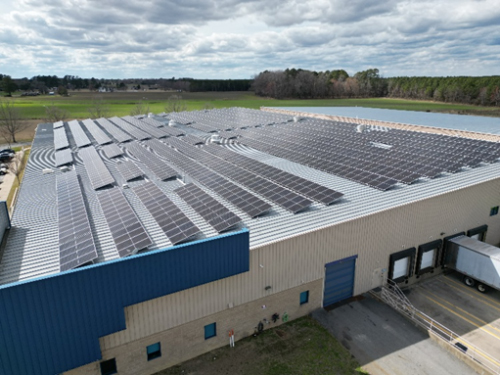
CMI Plastics is a family owned enterprise operated by the third generation, based on strong relationships. That's why when some of CMI Plastics' clients called on the company to reduce greenhouse gas emissions, CMI Plastics spared no effort to demonstrate its commitment to maintaining these meaningful partnerships. In addition to implementing energy efficiency upgrades and waste reduction practices at its factory in Eden, North Carolina, CMI Plastics was certified as a sustainable green printing partner factory in 2024, becoming the first company focused on thermoforming to receive this certification. Now, the company can add using on-site solar energy to meet 50% of its energy needs to its list of environmental sustainability practices. Megawatt Group and Pisgah Energy based in Asheville have collaborated on a 649 kW solar project. The system uses Trina Solar panels and SolarEdge inverters, which will be used as on-site generators. Steven Hasselbach, Managing Director of CMI Plastics, stated, "Pisgah Energy is an excellent partner. We need a team that can help handle all aspects of a project of this scale. They react quickly and have extensive knowledge. Any project will face challenges, and they have overcome these challenges and provided us with an incredible system to help us achieve our sustainable development goals Pisgah Energy is the chief designer/developer of the project and served as the general contractor during the project construction period. Evan Becka, President and Senior Developer of Pisgah Energy, said, "We had a great time working with the CMI Plastics team. This project faced many challenges, and their employees were tenacious and steadfastly committed to achieving their vision, which left a deep impression on me. CMI is committed to building and maintaining good relationships, which is understandable; Their way of serving customers and treating suppliers both reflect this. They have set an example for other companies in the plastic industry, recognizing that putting in more effort can greatly benefit the business
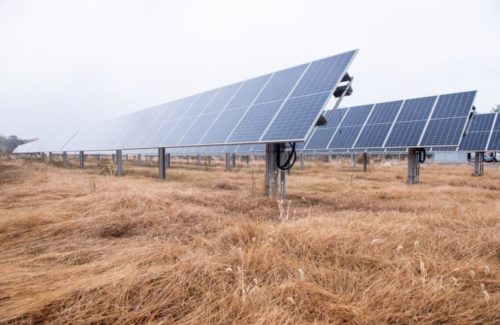
Minnesota Senators Nick A. Frentz (18, Democrat Farmer Labor), Bill Weber (21, Republican), and John A. Hoffman (34, Democrat Farmer Labor) have initiated a new bipartisan legislation proposing to end the state's newly reformed Low and Middle Income (LMI) Accessible Community Solar Garden (CSG) program by the end of 2028. CCSA、MnSEIA、Vote Solar、 In a joint statement opposing the bill, the Local Self Reliance Research Institute and Solar Energy United Neighbors stated, "This blatant setback is a gift to powerful utility companies that intend to protect their monopoly position and suppress competition, which directly harms the interests of families and small businesses in Minnesota Just a year ago, the Minnesota legislature modernized community solar projects to expand their usage to more residents. The state awarded the first batch of projects under the program in February 2025. The joint statement concludes, "Minnesota should lead the nation, not become the first state to repeal plans that bring conservation, energy independence, and economic opportunities to our communities. The legislature must reject SF 2855 and stand with Minnesota families

One of the most concerning issues for residents when introducing solar energy projects into the community is often their visual impact. Carefully designed and strategically implemented landscape buffer zones can address these issues by seamlessly integrating the project into the surrounding environment. However, many cities lack clear regulations or solar energy laws, resulting in inconsistent visual screening methods. Some projects failed to provide sufficient screening, while others included ornamental tree species based on community preferences rather than actual applicability. Although the main purpose of barriers is usually to block out unfavorable landscapes, using local evergreen tree species is an effective and sustainable solution. Unfortunately, many municipal authorities have overlooked local tree species when designating evergreen barriers, thus missing opportunities to enhance ecological benefits. Local evergreen trees and shrubs not only maintain their leaves throughout the year, but also promote local biodiversity by providing necessary habitats for wildlife. An effective landscape buffer zone should include a variety of trees, shrubs, flowering plants, and grasses. This diversity not only enhances visual appeal, but also brings additional ecological benefits, such as seasonal flowering and providing habitats for pollinating insects such as butterflies, bees, and hummingbirds. Although designing diverse landscapes requires careful planning and effort, the long-term advantages outweigh the initial investment and can create a beautiful, environmentally friendly, and sustainable environment. It is crucial to consider the planting conditions at specific locations in order to ensure successful landscape selection. Time management is particularly important because planting in summer can put pressure on the roots, leading to poor or failed plant growth. The optimal planting periods are spring and autumn, which are consistent with the natural growth cycle. Although the construction schedule may bring limitations, delaying planting is better than risking plant failure, as plant failure can damage the effectiveness of the buffer zone. The selection of plant material size is another key factor. Although smaller plants are easy to obtain, they may be difficult to compete with surrounding vegetation or inadvertently damaged during maintenance activities. Larger plant materials need to be procured as early as possible, but can provide immediate visual effects and help quickly establish plant barriers. In some cases, projects may require materials for contract planting, emphasizing the importance of early planning in the landscape selection process. Hiring experienced professionals is also crucial for ensuring project success. Many landscape installation failures are caused by inexperienced EPC or civil contractors installing without the necessary professional knowledge. Hiring skilled landscape professionals who provide assurance for their work ...
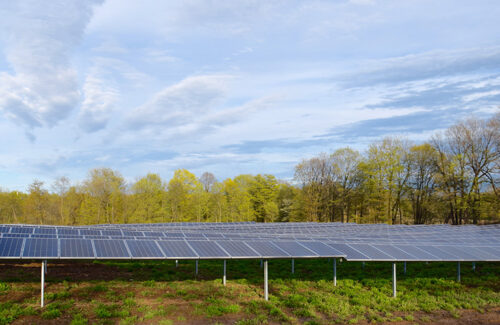
Ampion Renewable Energy has been selected as the community solar manager for the Erie County Low Income Sustainable Energy Program (ECLIPSE), a new initiative aimed at providing electricity savings for low to middle-income residents in Erie County, New York. Ampion will collaborate with Yili County to provide electricity savings for eligible residents through community solar energy. Currently, there are over 80000 low - and middle-income families in Yili County who can benefit from this program. We encourage residents to seize this opportunity, "said Mark C. Poloncarz, the Governor of Yili County. ECLIPSE community solar energy can be combined with other programs, such as the Home Energy Assistance Program (HEAP) and Empower+, to ensure that households can afford energy costs This program is applicable to all homeowners and tenants in Erie County who benefit from federal or state aid programs, including HEAP, Affordable Connect Program, Medicaid, Supplemental Nutrition Assistance Program, or Temporary Assistance for Poor Families. Brian Buzby, Director of Community Partnerships at Ampion, said, "Community solar allows power company customers to access renewable energy and save costs without installing or paying upfront fees. Through ECLIPSE, Erie County and Ampion make it easier for low-income residents to support solar energy while saving money. Our goal is to make the registration process as simple as possible. You only need a copy of your current electricity bill and proof that you are benefiting from government aid programs In addition to saving significant costs for impoverished families, this collaboration will also expand the amount of solar energy available in the northern part of New York State within the service areas of State Grid and New York State Electric and Gas Company (NYSE). Ampion recently announced that through community solar energy, users have saved over $42 million in electricity bills. These savings were achieved through the production of clean energy through a portfolio of over 1.5 GW community solar projects managed by Ampion.
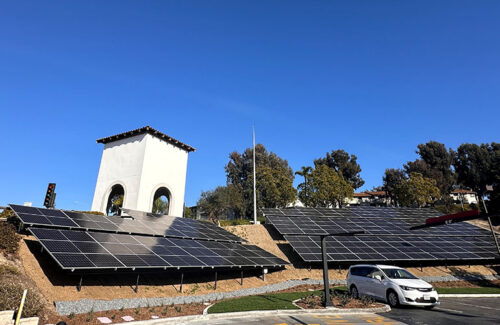
SolMicroGrid has announced the completion of a microgrid project at Chick-fil-A Quarry Creek in Oceanside, California. SolMicroGrid typically utilizes a combination of solar energy, on-site battery storage, and generators to provide customers with reliable and continuous power. The project for this Chick-fil-A restaurant includes an 81 kilowatt hour battery energy storage system and a 112 kilowatt solar cell array consisting of a canopy and ground mounted modules. All components of the project are controlled by an advanced energy management system that optimizes performance and maximizes the synergy between technologies. Due to the unique terrain and steep slope of the location, SolMicroGrid adopts ground installation technology specifically designed for rock slopes - using ground screws instead of standard concrete pouring foundations. One of the benefits of microgrid projects is that they can strategically deploy distributed energy resources, thereby reducing energy costs. The Oceanside project is expected to meet about one-third of the restaurant's annual energy needs, while grid electricity prices are 10% lower than grid electricity. Kirk Edelman, CEO of SolMicroGrid, said, "The solar and battery storage combination we provide for Chick-fil-A will help reduce energy costs while achieving sustainable development goals. We are pleased to have the opportunity to provide renewable energy to Chick-fil-A at a discounted price The latest achievement of SolMicroGrid and Chick-fil-A was achieved after the successful deployment of microgrids at the local owner operated locations of Chick-fil-A on Mendocino Avenue in Santa Rosa, California and March Lane on I-5 Interstate in Stockton. Peden Young, Chief Project Leader of the Sustainability Team at Chick-fil-A, stated, "Chick-fil-A's partnership with SolMicroGrid to invest in pilot solar microgrids demonstrates our commitment to environmental management. Using renewable energy on-site in our restaurant can reduce our impact on the environment, while also reflecting Chick-fil-A's determination to pursue the future and care for the planet
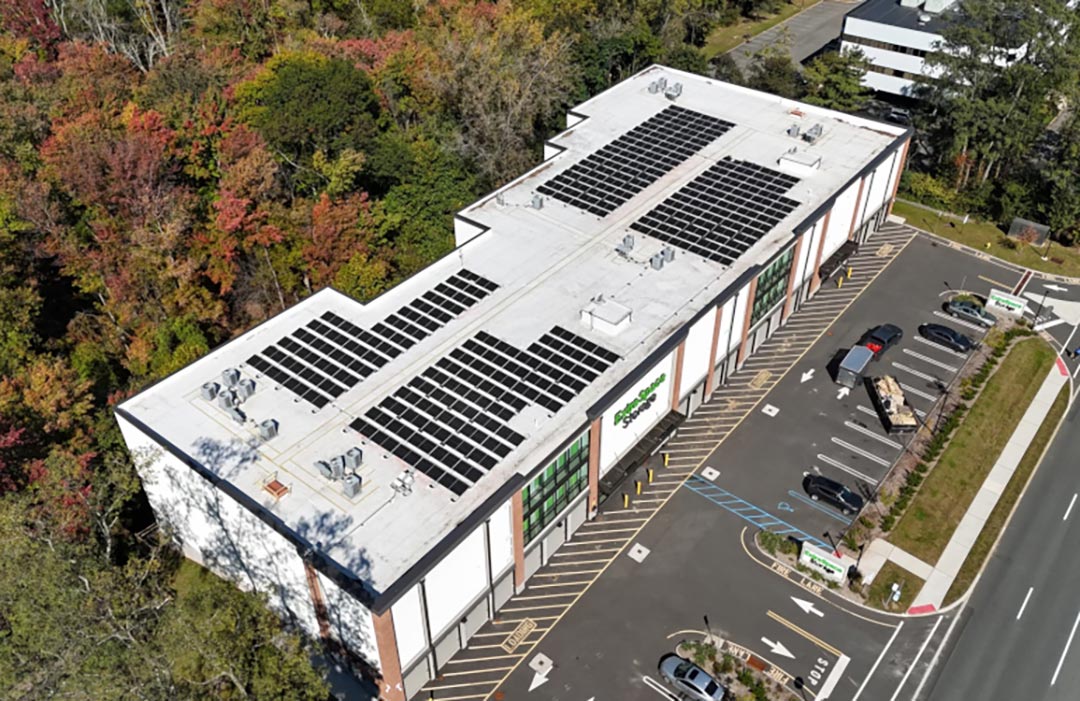
Key Properties has collaborated with Solect Energy to complete its first solar energy project. The 110 kW rooftop solar installation at the Key Properties Extra Space Storage building in Cedar Knolls, New Jersey is designed to offset 100% of the building's electricity usage. Adam Schlussel, Vice President of Key Properties, said, "Solar energy is a natural choice for us to reduce operating costs. By partnering with Solect Energy, we have reduced electricity costs from 17 cents per kilowatt hour to less than 1 cent and generated recurring income through incentive measures. For us, it's like adding another long-term tenant to the building Tony Johnson, Vice President of Business Development at Solect Energy, said, "Key Properties focuses on sustainability and maximizing financial value on this project, and we are pleased to work with them to achieve these two goals. This project not only offsets 100% of the building's electricity consumption, but also highlights the long-term economic benefits and environmental impact that solar energy can bring to commercial real estate owners The Cedar Knolls branch of Key Properties uses natural gas for heating and electricity for air conditioning and lighting. The solar energy system now completely offsets the electricity consumption of buildings. For their next solar project, Key Properties and Solect Energy are collaborating to design a system that will meet 100% of the energy needs of all electric buildings in the future.
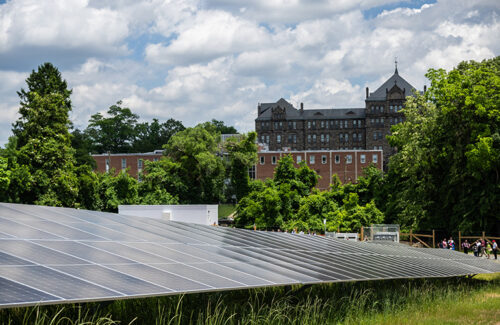
The facilities of Catholic University in the United States are located above the trees on both sides of the community solar project. This 7.5 MW project is located on Harwood Road across from the campus. Standard solar energy In cities like Washington, unoccupied land is very rare, let alone priceless. But the Catholic Church and CUA own more land than most organizations. I believe that besides the federal government, we are the largest landowner in Washington D.C., which is one of the reasons why we are able to develop 25 acres of solar panels on site, "said Gabrielle Choate, CUA Campus Sustainability Director. This 7.5 megawatt solar array occupies a portion of the 40 acre plot on CUA West Campus, with the remaining land reserved for ancient trees and nurseries. The project was developed by Standard Solar, which collaborated with CUA between 2009 and 2012 to develop a series of rooftop battery arrays and solar carports. Chuck VonDrehle, Senior Project Manager at Standard Solar, said, "The university has already utilized many net metering opportunities in other buildings... so this is a way for them to fulfill their previous commitments This century old university hired Standard Solar at the end of 2020, and in the following year, the developer collaborated with university, city, and community committees to design and approve community solar projects. This community solar project was launched in June 2024, and Standard Solar will lease the land for the next 20 years, but the developer has set the operating life of its project at 35 years. This array can accommodate approximately 1100 users and is open to residents in all eight districts of DC. CUA has ordered 12% of the total production of the array. They could have sold this land, which is very valuable in any urban area. They could have redeveloped it into a townhouse or even an academic building, and they still retained the option for the future because it is a temporary use for the next 20 years, which is just a short period of time for the life of a university, "Fennati said. The array on the west campus is obscured by natural surroundings on three sides and has no direct neighbors. Before construction, the site was an open space covered with wild shrubs and residual forests. The land slopes southward and is slightly flat to accommodate the solar cell array facing south. In order to build the system, some trees must be cut down, but many of them are donated to the urban forestry department of the regional transportation department. After processing, they will be provided to regional schools and high-risk youth projects for student projects and infrastructure construction. Another part of the wood is covered and used for CUA's community gardens and sidewalks. The remaining trees are considered important to the site, so installation personnel avoided the roots of ancient trees when piling. The array consists of FLEXRACK fixed tilt series brackets from QCells, CPS 275 kW series inverters, and ...
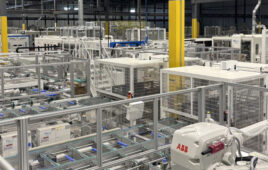
T1 Energy, the solar panel manufacturing player formerly known as FREYR, announced in its 2024 full-year report that it has chosen a site in Milam County, Texas, to establish a 5-GW solar cell manufacturing facility. The site located northeast of Austin will be labeled “G2 Austin,” while T1’s existing solar panel assembly outfit in Wilmer is called “G1 Dallas.” T1 has executed a lease and purchase option for 100 acres in the Advanced Manufacturing and Logistix Campus at Sandow Lakes. The company will invest up to $850 million into the site and is projected to create up to 1,800 new advanced manufacturing jobs. “Adding solar cell manufacturing is foundational to building out T1’s American supply chain. We are excited to take that next step right here in Texas, where the state’s leadership and business community has continued to develop the infrastructure, talent, and business climate necessary to support this project,” said Daniel Barcelo, T1’s CEO and Chairman of the Board. “We are grateful for the support we have received from the Wilmer, Austin, and Milam County communities and look forward to continuing to partner together moving forward.” T1 also announced that the ongoing ramp of production at the 5-GW solar panel assembly facility is proceeding ahead of schedule. During January and February 2025, the company produced more than 220 MW of panels at the plant that uses licensed Trina Solar technology. The site hosts four production lines for the utility-scale market producing a mix of PERC and TOPCon modules. T1 expects to reach 3.4 GW of production by year-end.
Categories
New Products
Tin Roof Rapid Solar Mounting System with Hanger Bolt Read More
Residential Small Solar Easy Bracket Kit for Home Balcony Read More
Automatic Single Pile Solar Tracker with 10 PV Panels Read More
Angle Adjustable Aluminum Easy Solar Panel Bracket for Garden Read More
Intelligent Single Post Dual Row Solar Tracking System Read More
5000ES Solar Off-Grid Energy Storage Inverter Supplier Read More
Multi Drive Double-Sided Single Axis Tracker System Read More
© Copyright: 2025 Xiamen Wintop New Energy Tech Co., Ltd.. All Rights Reserved.

IPv6 network supported